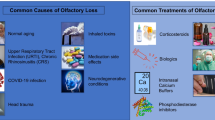Abstract
Aim of this investigation was to determine the distribution of gender and age with regard to major causes of olfactory loss, (1) trauma, (2) acute upper respiratory tract infections [URI], (3) sinunasal causes like sinusitis or nasal polyposis and (4) idiopathic. Data from more than 3,400 patients were used. In agreement with other studies, we found that (1) for trauma the female to male ratio was 0.80 and mean age was 46 years, (2) for URI the numbers were 2.39 and mean age was 57 years, (3) for sinunasal causes the numbers were 0.95 and 50 years, and (4) for idiopathic causes the female to male ratio was 1.13 and mean age was 57 years. These differences with regard to age and gender may indicate that hormonal changes may play a role in post-URI olfactory loss.


Similar content being viewed by others
References
Hummel T, Landis BN, Huttenbrink KB (2011) Dysfunction of the chemical senses smell and taste. Laryngorhinootologie 90(Suppl 1):S44–S55
Welge-Luessen A, Hummel T (2008) Riechstörungen postinfektiöser, posttraumatischer, medikantöser, toxischer, postoperativer und anderer Ätiologien. In: Hummel T, Welge-Luessen A (eds) Riech- und Schmeckstörungen: Thieme, pp 77–94
Yamagishi M, Fujiwara M, Nakamura H (1994) Olfactory mucosal findings and clinical course in patients with olfactory disorders following upper respiratory viral infections. Rhinology 32:113–118
Konstantinidis I, Haehner A, Frasnelli J et al (2006) Post-infectious olfactory dysfunction exhibits a seasonal pattern. Rhinology 44:135–139
Hummel T, Sekinger B, Wolf S, Pauli E, Kobal G (1997) “Sniffin Sticks”: olfactory performance assessed by the combined testing of odor identification, odor discrimination and olfactory threshold. Chem Senses 22:39–52
Birkhäuser M (2010) Platz der Östrogene in der Primärprävention der Osteoporose. J für Mineralstoffwechsel 17:11–20
Dhong HJ, Chung SK, Doty RL (1999) Estrogen protects against 3-methylindole-induced olfactory loss. Brain Res 824:312–315
Nathan BP, Tonsor M, Struble RG (2012) Long-term effects of estradiol replacement in the olfactory system. Exp Neurol 237:1–7
Hughes LF, McAsey ME, Donathan CL, Smith T, Coney P, Struble RG (2002) Effects of hormone replacement therapy on olfactory sensitivity: cross-sectional and longitudinal studies. Climacteric 5:140–150
Acknowledgment
We would like to thank Dr. W. S. Cain for his comments during the ACHEMS conference 2012 which sparked this analysis.
Author information
Authors and Affiliations
Corresponding author
Rights and permissions
About this article
Cite this article
Fark, T., Hummel, T. Olfactory disorders: distribution according to age and gender in 3,400 patients. Eur Arch Otorhinolaryngol 270, 777–779 (2013). https://doi.org/10.1007/s00405-012-2108-2
Received:
Accepted:
Published:
Issue Date:
DOI: https://doi.org/10.1007/s00405-012-2108-2




